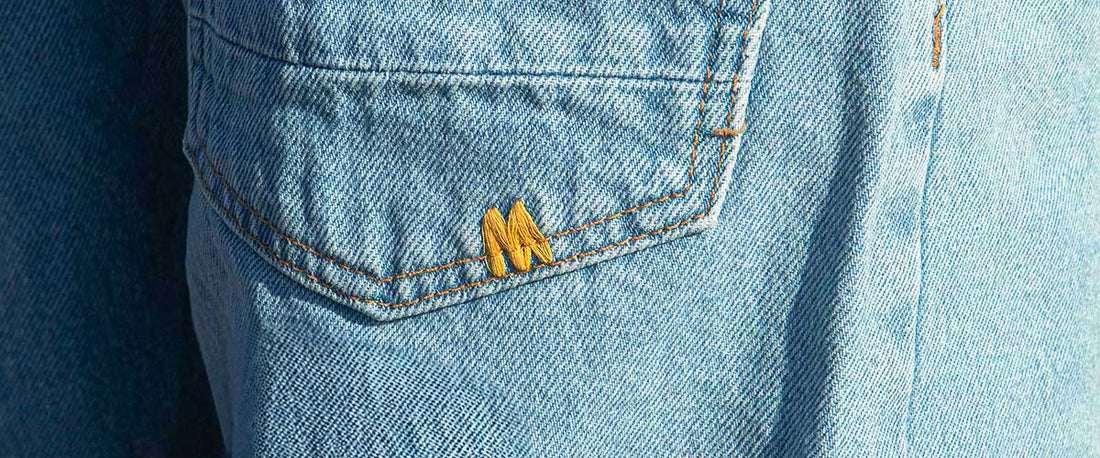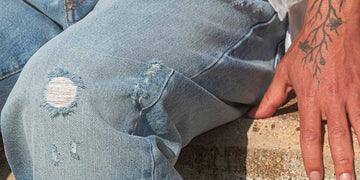
DENIM: THE FABRIC THAT CHANGED EVERYTHING
There was a time when denim wasn’t a symbol, wasn’t a style, wasn’t even a choice.
It was just a fabric — rough, uneven, heavy on the skin and harder in the wash — made to endure what people couldn’t avoid.
It began in Genova, long before streetwear, before cinema, before the idea that what you wear might say something about who you are.
Back then, clothes were tools.
And this particular cloth — dyed deep in natural indigo, almost black at first, stiff like canvas but built to break in — was thrown over the backs of dockworkers, sailors, soldiers, anyone who lived by the sea and needed something that wouldn’t fall apart under pressure.
They called it Bleu de Gênes — the Blue of Genoa.
It wasn’t beautiful. It wasn’t soft. It simply worked.
Across the water in Nîmes, France, someone tried to copy it.
They didn’t get it quite right — and that mistake changed everything.
What they produced was stronger, denser, cut with a diagonal weave that added resilience and subtle stretch, a fabric that didn’t fight the body, but worked with it.
They called it Serge de Nîmes.
Denim, for short.
And just like that, through ports and errors and necessity, a legacy was woven.
Not because anyone meant to — but because someone, somewhere, needed something that could last.
It travelled. It moved with people, with work, with time.
It crossed the Atlantic, was cut and sewn and riveted in dry warehouses and dusty barns, and worn into mines and fields and steel yards, where it was judged not by how it looked, but by whether it survived.
But denim has always had this strange quality — this way of remembering what it’s been through.
The way it fades not uniformly, but personally.
The way it creases where you lean and splits where you push.
The way it tells the truth about how you live, whether or not you want it to.
And maybe that’s why, when it finally landed on movie screens —
on James Dean slouched against a wall, Brando with that look that said don’t ask — denim didn’t feel like costume. It felt like memory. Like resistance.
The rebels didn’t invent the look.
They just gave it a new rhythm.
From there, it became something else.
Dragged through punk clubs with torn knees and patches that screamed.
Bagged low through boom bap rhythms and concrete stairwells.
Faded to grey in the smoke of afterparties and parking lots.
Folded on floors, crumpled in taxis, worn straight from stage to street without apology.
Denim became the one fabric that never asked to be styled.
Because it already knew who it was.
It didn’t follow seasons. It followed bodies.
It wasn’t just clothing anymore — it was archive. It was tension.
It was every version of you layered over the last.
And while denim spread west, something different was happening far to the east — quiet, meticulous, obsessive in the best possible way.
In Japan, denim didn’t just survive. It was reborn.
On vintage shuttle looms rescued from American mills long gone silent,
weavers began crafting denim not for mass production, but for depth — for texture, for slowness, for soul.
They chased irregularity. Celebrated fading.
Studied shrinkage, selvedge, tension, yarn weight — not to control the outcome,
but to honor it.
Japanese denim became something like jazz on cloth: structured, yes, but improvised at the edges, always unique, always imperfect, always alive.
And in that imperfection, they rediscovered the truth: that denim is only half made in the factory.
The rest is finished by whoever wears it — crease by crease, wash by wash, day by day.
It was never about what it looked like new. It was about what it would become.
At KLSH, we work with denim not because of what it represents, but because of what it remembers.
We choose fabrics that carry weight.
We cut them for movement, not performance.
We bleach them, break them, fade them, not to fake a story, but to let yours begin at the surface — not pristine, but ready.
We treat denim the way it was always meant to be treated:
not as an image, but as a tool that becomes you the moment you start living in it.
Because the truth is, you don’t wear denim for others.
You wear it for the silence between places, for the weight it holds after a night that didn’t go as planned, for the shape it takes after three months of walking through the same streets with the same questions in your head.
It becomes yours the way a song becomes yours.
Not because you wrote it, but because it came on at the right moment and something in your body said: stay here.
So if you’ve ever looked at a pair of jeans and seen more than fabric, if you’ve ever felt the weight of your own story stitched into the grain, if you’ve ever worn something until it felt like part of your pulse — then you already understand.
This isn’t just history.
It’s tension woven into cloth.
It’s movement that doesn’t forget.
It’s denim.
And it’s still alive.
No comments







0 comments